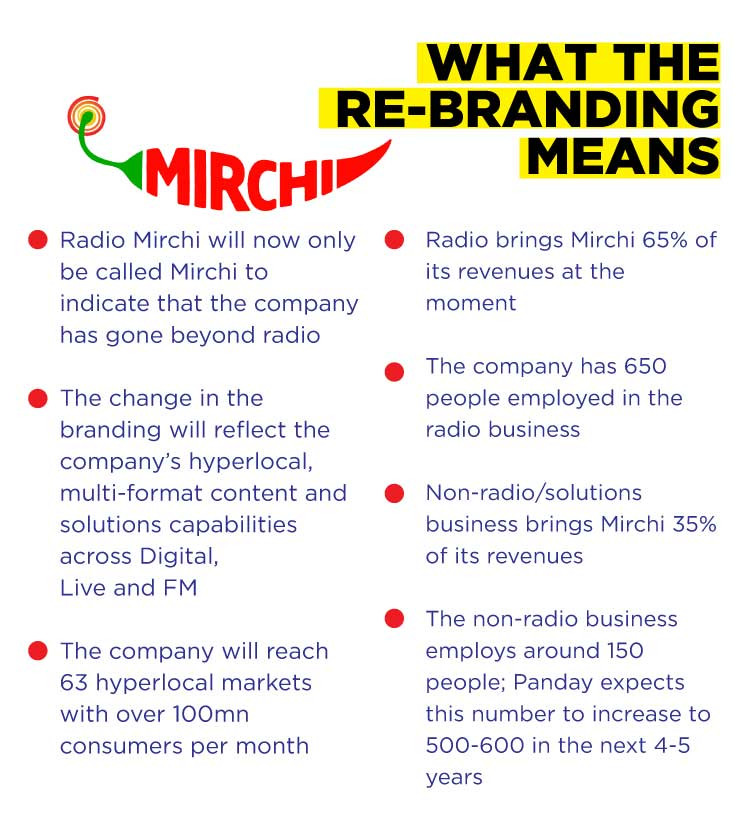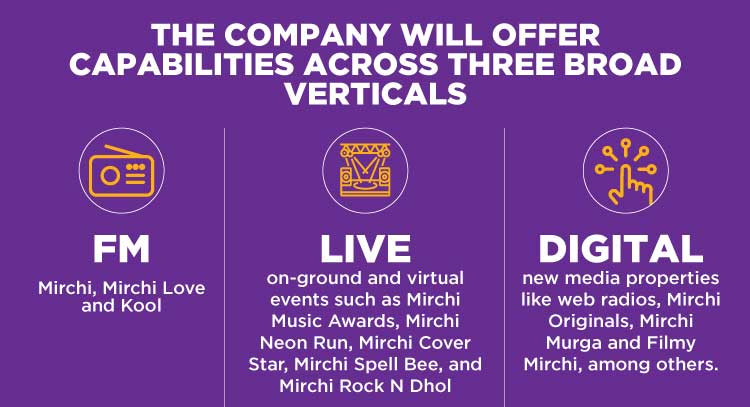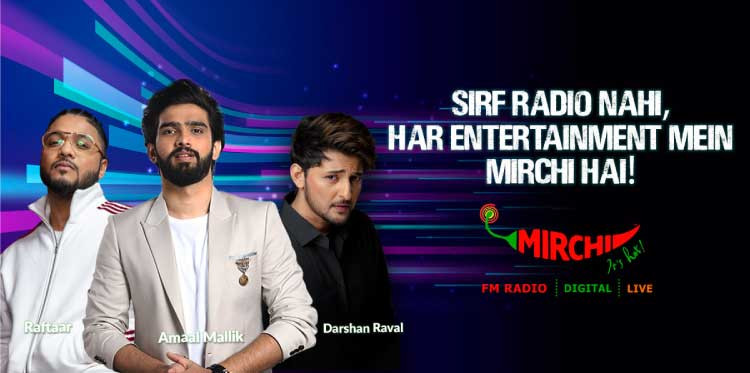HOW MIRCHI IS SPICING IT UP
Prashant Panday, MD & CEO, Mirchi on the transformation of the iconic Radio Mirchi brand into a city-centric, entertainment company
Prashant Panday, MD & CEO, Mirchi on the transformation of the iconic Radio Mirchi brand into a city-centric, entertainment company

Prashant Panday, MD & CEO, Mirchi on the transformation of the iconic Radio Mirchi brand into a city-centric, entertainment company

 The renewed brand identity also heightens the company’s focus and forte to build customised city-centric brand solutions for its advertisers. “To give you an example, if I was to do an activity for a brand in let’s say Chandigarh – I will firstly be able to offer the brand my radio station’s reach in the city. In addition, we also have a Punjabi YouTube channel, a celebrity RJ with whom we will make a video and put on the Punjabi YouTube channel. We also have connections with local influencers that can be leveraged for the brand. We can offer access to other touch points like retail, malls, markets, etc. Therefore, what we can offer a brand is solutions that no one else can provide,” explains Panday. He explains that Mirchi’s capabilities will cut across three main spaces – Digital, Live and FM. Its FM arm features channels like Mirchi, Mirchi Love and Kool. Under the Live offering, the brand will continue with its on-ground and virtual events such as Mirchi Music Awards, Mirchi Neon Run and Mirchi Rock N Dhol. The Digital arm of business focuses on new media properties like web radios, Mirchi Originals, Mirchi Murga and Filmy Mirchi, among others. The company also has a formidable presence across multiple platforms – with 170 digital influencers, 24 radio stations, 12 YouTube channels and a presence across various social media platforms.
Edited excerpts from an interview with Prashant Panday
Q] With the new brand solutions that Mirchi offers, what is the kind of positioning you’re looking at for the company?
We’ve been doing a lot more than Radio for many years now. Just to give you an example, in FY20 only 65% of our revenues came from radio, and 35% came from what we call loosely the ‘Solutions’ business. The solutions business doesn’t involve selling inventory to clients, but rather it involves understanding their problems and identifying solutions for them. The solutions involve multiple media and touch points, because you can’t solve real life problems by just advertising on one medium, right? Our strength lies really in our presence in different cities and states – we are present in 63 cities and we can step in and create solutions for a client in Jabalpur, Jodhpur or even Coimbatore. Our aim is to become a one-stop shop solution for brands. What this new brand name and positioning really will do is formalise everything we’ve been doing beyond the radio business. It’s a big thing for a consumer company to fundamentally change its logo and it’s also very symbolic this time, because what we’re doing is that we’re dropping radio itself from Radio Mirchi. That’s a decisive, big step. The second change is in the tagline of course, which was previously ‘Mirchi sunne wale always khush’, a line that was more appropriate for the audio medium. We’ve reverted back to our earlier line now, which is ‘it’s hot!’
The renewed brand identity also heightens the company’s focus and forte to build customised city-centric brand solutions for its advertisers. “To give you an example, if I was to do an activity for a brand in let’s say Chandigarh – I will firstly be able to offer the brand my radio station’s reach in the city. In addition, we also have a Punjabi YouTube channel, a celebrity RJ with whom we will make a video and put on the Punjabi YouTube channel. We also have connections with local influencers that can be leveraged for the brand. We can offer access to other touch points like retail, malls, markets, etc. Therefore, what we can offer a brand is solutions that no one else can provide,” explains Panday. He explains that Mirchi’s capabilities will cut across three main spaces – Digital, Live and FM. Its FM arm features channels like Mirchi, Mirchi Love and Kool. Under the Live offering, the brand will continue with its on-ground and virtual events such as Mirchi Music Awards, Mirchi Neon Run and Mirchi Rock N Dhol. The Digital arm of business focuses on new media properties like web radios, Mirchi Originals, Mirchi Murga and Filmy Mirchi, among others. The company also has a formidable presence across multiple platforms – with 170 digital influencers, 24 radio stations, 12 YouTube channels and a presence across various social media platforms.
Edited excerpts from an interview with Prashant Panday
Q] With the new brand solutions that Mirchi offers, what is the kind of positioning you’re looking at for the company?
We’ve been doing a lot more than Radio for many years now. Just to give you an example, in FY20 only 65% of our revenues came from radio, and 35% came from what we call loosely the ‘Solutions’ business. The solutions business doesn’t involve selling inventory to clients, but rather it involves understanding their problems and identifying solutions for them. The solutions involve multiple media and touch points, because you can’t solve real life problems by just advertising on one medium, right? Our strength lies really in our presence in different cities and states – we are present in 63 cities and we can step in and create solutions for a client in Jabalpur, Jodhpur or even Coimbatore. Our aim is to become a one-stop shop solution for brands. What this new brand name and positioning really will do is formalise everything we’ve been doing beyond the radio business. It’s a big thing for a consumer company to fundamentally change its logo and it’s also very symbolic this time, because what we’re doing is that we’re dropping radio itself from Radio Mirchi. That’s a decisive, big step. The second change is in the tagline of course, which was previously ‘Mirchi sunne wale always khush’, a line that was more appropriate for the audio medium. We’ve reverted back to our earlier line now, which is ‘it’s hot!’
 Q] Would you say that the solutions Mirchi offers then are somewhat akin to those of a media or creative agency?
So think of it like this. When we go to a client, we are very clear that we are not competing with their creative agency or their media agency. We’re not the client’s media agency either. Our positioning is clear – we are a one-stop shop and we would rather describe ourselves as solution consultants. When you have a problem, you come to us, and we will solve the problem for you. And if that means we need to engage and work with your creative or media agency, we will do that. If you need us to hire an event company, we can do that! What also sets us apart is the fact that we are present across 63 cities and can therefore, customise solutions for you at a hyperlocal level.
Q] How are you communicating the new company’s positioning to advertisers and consumers?
So basically, on radio itself on a weekly basis, we reach almost 40 million people across the country. So, if I were to give you a monthly number for radio, it would be about 40% higher. So let’s say that we reach about 55 million people on a monthly basis on radio. On digital platforms like YouTube, I can reach about 60 to 70 million people a month. Further on Gaana and wherever we stream our radio stations, we reach a few more million people there. And every once in a while when we do a television show like we did with the Mirchi Music Awards, which will again come up in February-March, we reach around 135 million people. The point I am making is that we have a lot of reach within our group and we will also include other touch points like Print with the TOI as well as some of the digital assets from the Times Group. Wherever possible, we will also do on ground activations in cities. We also have a launch video featuring Raftaar, Amaal Mallik and Darshan Raval that we will be releasing across our social media. In addition, we have a good base of influencers to amplify that video – we have a large media plan to communicate our new company positioning.
Q] Would you say that the solutions Mirchi offers then are somewhat akin to those of a media or creative agency?
So think of it like this. When we go to a client, we are very clear that we are not competing with their creative agency or their media agency. We’re not the client’s media agency either. Our positioning is clear – we are a one-stop shop and we would rather describe ourselves as solution consultants. When you have a problem, you come to us, and we will solve the problem for you. And if that means we need to engage and work with your creative or media agency, we will do that. If you need us to hire an event company, we can do that! What also sets us apart is the fact that we are present across 63 cities and can therefore, customise solutions for you at a hyperlocal level.
Q] How are you communicating the new company’s positioning to advertisers and consumers?
So basically, on radio itself on a weekly basis, we reach almost 40 million people across the country. So, if I were to give you a monthly number for radio, it would be about 40% higher. So let’s say that we reach about 55 million people on a monthly basis on radio. On digital platforms like YouTube, I can reach about 60 to 70 million people a month. Further on Gaana and wherever we stream our radio stations, we reach a few more million people there. And every once in a while when we do a television show like we did with the Mirchi Music Awards, which will again come up in February-March, we reach around 135 million people. The point I am making is that we have a lot of reach within our group and we will also include other touch points like Print with the TOI as well as some of the digital assets from the Times Group. Wherever possible, we will also do on ground activations in cities. We also have a launch video featuring Raftaar, Amaal Mallik and Darshan Raval that we will be releasing across our social media. In addition, we have a good base of influencers to amplify that video – we have a large media plan to communicate our new company positioning.
 Q] The pandemic has impacted the Radio sector, much like it has many others. Would you say that this new company positioning is in response to that?
We have actually been in the solutions business for many years and even before the pandemic hit, around 35% of our revenues came from the non-radio business. So no, this is not in response to the pandemic. What we have done is use the last 7-8 months’ time to reorganise the company. So, today we have 160 people who are devoted in my company to the solutions business. And we are 650 people in the radio business. And then we have another 100-150 people in all the support functions, so we’re about 950 odd people in the company. And in the next three to five years’ time, the radio team will probably remain the same or grow marginally, maybe 650 will become 700. But the non-radio businesses team will grow from 150 odd and become 500 to 600.
Q] Talk to us about the radio business. While of course, the non-radio solutions side of things has really started to take off, what are some of the things you’re doing to keep advertiser interest sustained in radio?
Yeah, so on the radio side, obviously we have taken a lot of initiatives on cost cutting and all that. One thing I would like to point out is that in any situation like this, when you’re cutting costs, what you’re forced to do is to look at those costs against which the minimum value is being created. So you cut those costs where you lose the least amount of value in the process. And because of that, many of these cost cuts are actually permanent cost cuts. So these cost cuts will remain even in the future, and it is not like these cuts will be reversed since they have not caused much of a value loss and we can sustain them. This is something that not just we, but also other players in the business have done. The other thing is to understand that sectors like retail and travel that have been hit by the pandemic will take at least two years to revive. However, a whole new set of advertisers will also emerge, and sometimes small advertisers who didn’t advertise in the past may seize the opportunity to do that now. So what we have done to boost advertiser revenues is we have tied up with an Australian bunch of people who run a company called Boost. What we do with them is identify around 7,500 small and medium scale businesses in Dehi, Mumbai and Bangalore who are typical non-advertisers but who can benefit from advertising. We have already reached out to 4,500 of them and while all of them may not start spending immediately because their businesses are also hit – the important thing is the channels of communication are open. Once they are ready to spend, we will be able to reach out and get them to spend on either radio or the solutions portfolio.
Q] With the new company positioning now, what will your key focus areas be in the year ahead? And what is the kind of vision you have defined for Mirchi?
One of the key focus areas is of course to sustain the cost initiative. The second focus area is to keep conversations with clients going and ensure the business grows. The third and perhaps most important one is to ensure that we should not lose key people during this period of time. Some sectors like e-commerce and digital companies are opening up faster than other sectors – so one of the things that I’ll be paying a lot of attention to in 2021 is exactly this, which is to manage the team. Hold the retention down. Keep the morale up. As far as the vision is concerned, today we are known across the world as Radio Mirchi. What I would like after four to five years is basically to be known as an entertainment company. We are not a television company and we are not Netflix. Our whole vision is that we are an entertainment company, which is rooted in 63 different places, and therefore we can create a connect with people at each of these places in their local languages.
Q] Looking back at 2020, a most challenging year, what have some of the big learnings and highlights been for you?
I really believe that any crisis that hits the company is actually possibly the only time to explore its inner strengths, weaknesses and just make the most out of it. So like I told you, we have taken a lot of initiatives on cost management. And much of that is permanent, because we have suffered very little value loss in the process. So that’s been a learning. And the other thing, of course is the strengthening of the brand. During times of crisis, consumers usually turn to reliable, trustworthy brands. So what type of programming you put out, how do you stay in connect with your listeners – all of that matters. We were not off-air for a single day, we have covered every single story which relates to people on COVID, we’ve given people hope, and given them a reason to smile. One of the big learnings then is that you should make the most of content generation during this time as well. Most importantly, as I mentioned – we used this time, as I mentioned to basically transform the organisation. So yes, the biggest learning is that when a crisis hits, you should really make the most out of it.
Q] The pandemic has impacted the Radio sector, much like it has many others. Would you say that this new company positioning is in response to that?
We have actually been in the solutions business for many years and even before the pandemic hit, around 35% of our revenues came from the non-radio business. So no, this is not in response to the pandemic. What we have done is use the last 7-8 months’ time to reorganise the company. So, today we have 160 people who are devoted in my company to the solutions business. And we are 650 people in the radio business. And then we have another 100-150 people in all the support functions, so we’re about 950 odd people in the company. And in the next three to five years’ time, the radio team will probably remain the same or grow marginally, maybe 650 will become 700. But the non-radio businesses team will grow from 150 odd and become 500 to 600.
Q] Talk to us about the radio business. While of course, the non-radio solutions side of things has really started to take off, what are some of the things you’re doing to keep advertiser interest sustained in radio?
Yeah, so on the radio side, obviously we have taken a lot of initiatives on cost cutting and all that. One thing I would like to point out is that in any situation like this, when you’re cutting costs, what you’re forced to do is to look at those costs against which the minimum value is being created. So you cut those costs where you lose the least amount of value in the process. And because of that, many of these cost cuts are actually permanent cost cuts. So these cost cuts will remain even in the future, and it is not like these cuts will be reversed since they have not caused much of a value loss and we can sustain them. This is something that not just we, but also other players in the business have done. The other thing is to understand that sectors like retail and travel that have been hit by the pandemic will take at least two years to revive. However, a whole new set of advertisers will also emerge, and sometimes small advertisers who didn’t advertise in the past may seize the opportunity to do that now. So what we have done to boost advertiser revenues is we have tied up with an Australian bunch of people who run a company called Boost. What we do with them is identify around 7,500 small and medium scale businesses in Dehi, Mumbai and Bangalore who are typical non-advertisers but who can benefit from advertising. We have already reached out to 4,500 of them and while all of them may not start spending immediately because their businesses are also hit – the important thing is the channels of communication are open. Once they are ready to spend, we will be able to reach out and get them to spend on either radio or the solutions portfolio.
Q] With the new company positioning now, what will your key focus areas be in the year ahead? And what is the kind of vision you have defined for Mirchi?
One of the key focus areas is of course to sustain the cost initiative. The second focus area is to keep conversations with clients going and ensure the business grows. The third and perhaps most important one is to ensure that we should not lose key people during this period of time. Some sectors like e-commerce and digital companies are opening up faster than other sectors – so one of the things that I’ll be paying a lot of attention to in 2021 is exactly this, which is to manage the team. Hold the retention down. Keep the morale up. As far as the vision is concerned, today we are known across the world as Radio Mirchi. What I would like after four to five years is basically to be known as an entertainment company. We are not a television company and we are not Netflix. Our whole vision is that we are an entertainment company, which is rooted in 63 different places, and therefore we can create a connect with people at each of these places in their local languages.
Q] Looking back at 2020, a most challenging year, what have some of the big learnings and highlights been for you?
I really believe that any crisis that hits the company is actually possibly the only time to explore its inner strengths, weaknesses and just make the most out of it. So like I told you, we have taken a lot of initiatives on cost management. And much of that is permanent, because we have suffered very little value loss in the process. So that’s been a learning. And the other thing, of course is the strengthening of the brand. During times of crisis, consumers usually turn to reliable, trustworthy brands. So what type of programming you put out, how do you stay in connect with your listeners – all of that matters. We were not off-air for a single day, we have covered every single story which relates to people on COVID, we’ve given people hope, and given them a reason to smile. One of the big learnings then is that you should make the most of content generation during this time as well. Most importantly, as I mentioned – we used this time, as I mentioned to basically transform the organisation. So yes, the biggest learning is that when a crisis hits, you should really make the most out of it.